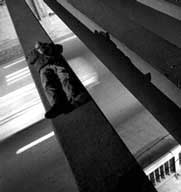Taking pictures in low light situations (without a flash) generally produces interesting photographs. The low ambient light of the surrounding environment creates a mood that straight flash photography cannot match. There are however some special challenges to shooting in low light situations. The most important considerations are metering, shutter speeds and film speed.
If you have a spotmeter, that would be your tool of choice in order to determine the exposure of a low light situation. If you don’t, get as close to your subject as possible and take a reading from the most important element in your shot. Lock in that reading, back up and take the picture. Do not include extremely bright elements (i.e. a candles ) in the center of your viewfinder when taking your reading.
Most people cannot hold a camera fitted with a normal lens at speeds of 1/30 of a second or slower without blurring the photograph. Likewise, most humans or animals cannot stay still (unless they are lying down or standing against something) for longer than 1/60th of a second. (See theHoly Trinity of Photography for a fuller explanation).
In order to avoid camera blur use a tripod and a cable release to shoot at speeds of 1/30 or slower.

This photograph was taken on a tripod using Kodak T-max 3200. Exposure was F-5.6 at 1/8 sec. Note the blurred bus coming from the left side.
Film speed is another consideration when it comes to low light situations. There are many different available speeds but speeds of 1000 or greater are perfectly suited for low light situations. This is due to the film’s increased sensitivity to light; You need less light to expose the photograph. This increased film speed also lets you use a much faster shutter speed than say 100 speed film.
Fast films are available in both black and white and colour, and in negative or slide film. Currently the fastest colour films are available in speeds of 1000 and 1600. These are made by Fuji and Kodak respectively. The fastest black and white film is 3200. It is made by both Kodak and Ilford. These films are available from professional photography stores, and are slightly more expensive than lower speed film.
The only possible drawback (it’s a matter of taste) of using fast film is grain. The faster the film the larger the film grain. This film grain is not that apparent on small prints but is readily apparent on enlargements.
The faster the film speed the less light it takes to correctly expose the photograph.


